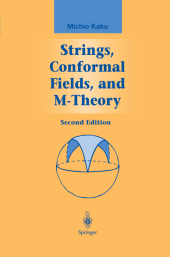 Neuerscheinungen 2012Stand: 2020-01-07 |
Schnellsuche
ISBN/Stichwort/Autor
|
Herderstra▀e 10
10625 Berlin
Tel.: 030 315 714 16
Fax 030 315 714 14
info@buchspektrum.de |

Michio Kaku
Strings, Conformal Fields, and M-Theory
2. Aufl. 2012. xv, 531 S. XV, 531 p. 235 mm
Verlag/Jahr: SPRINGER, BERLIN 2012
ISBN: 1-461-26792-7 (1461267927)
Neue ISBN: 978-1-461-26792-8 (9781461267928)
Preis und Lieferzeit: Bitte klicken
Building on the foundations laid in his Introduction to Superstrings and M Theory, Professor Kaku discusses such topics as the classification of conformal string theories, knot theory, the Yang-Baxter relation, quantum groups, and the insights into 11-dimensional strings recently obtained from M-theory. New chapters discuss such topics as Seiberg-Witten theory, M theory and duality, and D-branes. Throughout, the author conveys the vitality of the current research and places readers at its forefront. Several chapters reviewing the fundamentals of string theory, making the presentation of the material self-contained while keeping overlap with the earlier book to a minimum.
┤I Conformal Field Theory and Perturbation Theory.- 1 Introduction to Superstrings.- 1.1 Quantizing the Relativistic String.- 1.2 Scattering Amplitudes.- 1.3 Supersymmetry.- 1.4 2D SUSY Versus 10D SUSY.- 1.5 Types of Strings.- 1.6 Summary.- 2 BPZ Bootstrap and Minimal Models.- 2.1 Conformal Symmetry in D Dimensions.- 2.2 Conformal Group in Two Dimensions.- 2.3 Representations of the Conformal Group.- 2.4 Fusion Rules and Correlations Function.- 2.5 Minimal Models.- 2.6 Fusion Rules for Minimal Models.- 2.7 Superconformal Minimal Series.- 2.8 Summary.- 3 WZW Model, Cosets, and Rational Conformal Field Theory.- 3.1 Compactification and the WZW Model.- 3.2 Frenkel-Kac Construction.- 3.3 GKO Coset Construction.- 3.4 Conformal and Current Blocks.- 3.5 Racah Coefficients for Rational Conformal Field Theory.- 3.6 Summary.- 4 Modular Invariance and the A-D-E Classification.- 4.1 Dehn Twists.- 4.2 Free Fermion and Boson Characters.- 4.3 GSO and Supersymmetry.- 4.4 Minimal Model Characters.- 4.5 Affine Characters.- 4.6 A-D-E Classification.- 4.7 Higher Invariants and Simple Currents.- 4.8 Diagonalizing the Fusion Rules.- 4.9 RCFT: Finite Number of Primary Fields.- 4.10 Summary.- N = 2 SUSY and Parafermions.- 5.1 Calabi-Yau Manifolds.- 5.2 N = 2 Superconformal Symmetry.- 5.3 N = 2 Minimal Series.- 5.4 N = 2 Minimal Models and Calabi-Yau Manifolds.- 5.5 Parafermions.- 5.6 Supersymmetric Coset Construction.- 5.7 Hermitian Spaces.- 5.8 Summary.- 6 Yang-Baxter Relation.- 6.1 Statistical Mechanics and Critical Exponents.- 6.2 One-Dimensional Ising Model.- 6.3 Two-Dimensional Ising Model.- 6.4 RSOS and Other Models.- 6.5 Yang-Baxter Relation.- 6.6 Solitons and the Yang-Baxter Equation.- 6.7 Summary.- 7 Toward a Classification of Conformal Field Theories.- 7.1 Feigin-Fuchs Free Fields.- 7.2 Free Field Realizations of Coset Theories.- 7.3 Landau-Ginzburg Potentials.- 7.4 N = 2 Chiral Rings.- 7.5 N = 2 Landau-Ginzburg and Catastrophe Theory.- 7.6 Zamolodchikov┤s c Theorem.- 7.7 A-D-E Classification of c = 1 Theories.- 7.8 Summary.- 8 Knot Theory and Quantum Groups.- 8.1 Chern-Simons Approach to Conformal Field Theory.- 8.2 Elementary Knot Theory.- 8.3 Jones Polynomial and the Braid Group.- 8.4 Quantum Field Theory and Knot Invariants.- 8.5 Knots and Conformal Field Theory.- 8.6 New Knot Invariants from Physics.- 8.7 Knots and Quantum Groups.- 8.8 Hecke and Temperley-Lieb Algebras.- 8.9 Summary.- II Nonperturbative Methods.- 9 String Field Theory.- 9.1 First Versus Second Quantization.- 9.2 Light Cone String Field Theory.- 9.3 Free BRST Action.- 9.4 Interacting BRST String Field Theory.- 9.5 Four-Point Amplitude.- 9.6 Superstring Field Theory.- 9.7 Picture Changing.- 9.8 Superstring Action.- 9.9 Summary.- 10 Non polynomial String Field Theory.- 10.1 Four-String Interaction.- 10.2 N-Sided Polyhedra.- 10.3 Nonpolynomial Action.- 10.4 Conformal Maps.- 10.5 Tadpoles.- 10.6 Summary.- 11 2D Gravity and Matrix Models.- 11.1 Exactly Solvable Strings.- 11.2 2D Gravity and KPZ.- 11.3 Matrix Models.- 11.4 Recursion Relations.- 11.5 KdV Hierarchy.- 11.6 Multimatrix Models.- 11.7 D = 1 Matrix Models.- 11.8 Summary.- 12 Topological Field Theory.- 12.1 Unbroken Phase of String Theory.- 12.2 Topology and Morse Theory.- 12.3 Sigma Models and Floer Theory.- 12.4 Cohomological Topological Field Theories.- 12.5 Correlation Functions.- 12.6 Topological Sigma Models.- 12.7 Topological 2D Gravity.- 12.8 Correlation Functions for 2D Topological Gravity.- 12.9 Virasoro Constraint, W-Algebras, and KP Hierarchies.- 12.10 Summary.- 13 Seiberg-Witten Theory.- 13.1 Introduction.- 13.2 Electric-Magnetic Duality.- 13.3 Holomorphic Potentials.- 13.4 N = 1 SUSY QCD.- 13.4.1 Nf Nc.- 13.4.2 Nf = Nc.- 13.4.3 Nf = Nc + 1.- 13.4.4 Nc + 2 ? Nf ? 3/2Nc.- 13.4.5 3/2Nc Nf 3Nc.- 13.4.6 N ? 3Nc.- 13.4.7 SO(Nc) SUSY Gauge Theory.- 13.5 N = 2 SUSY Gauge Theory.- 13.6 SU(N)N = 2 SUSY Gauge Theo


